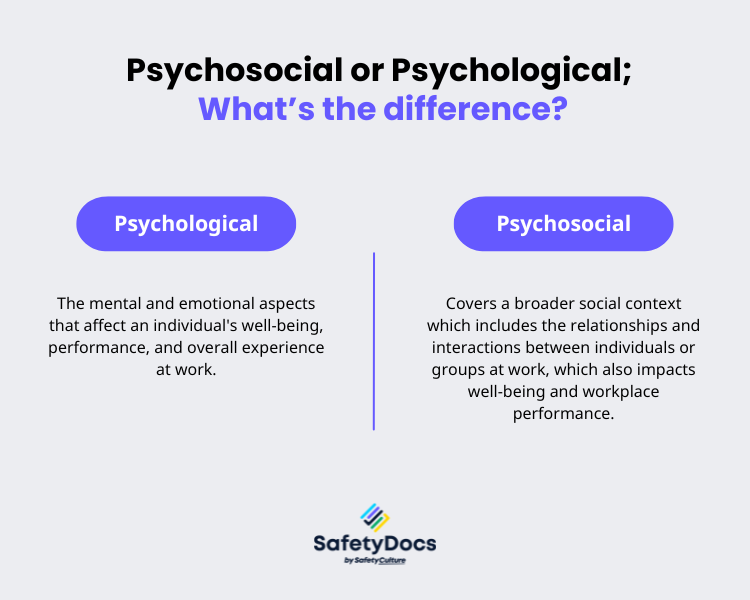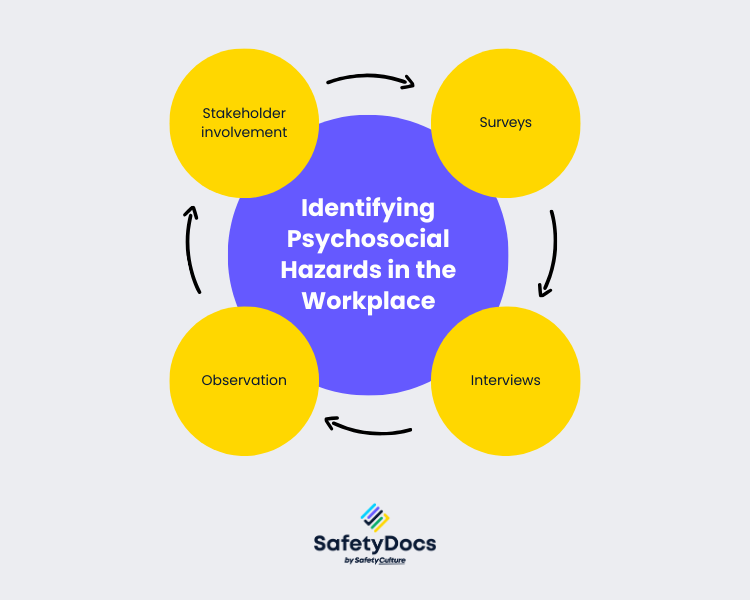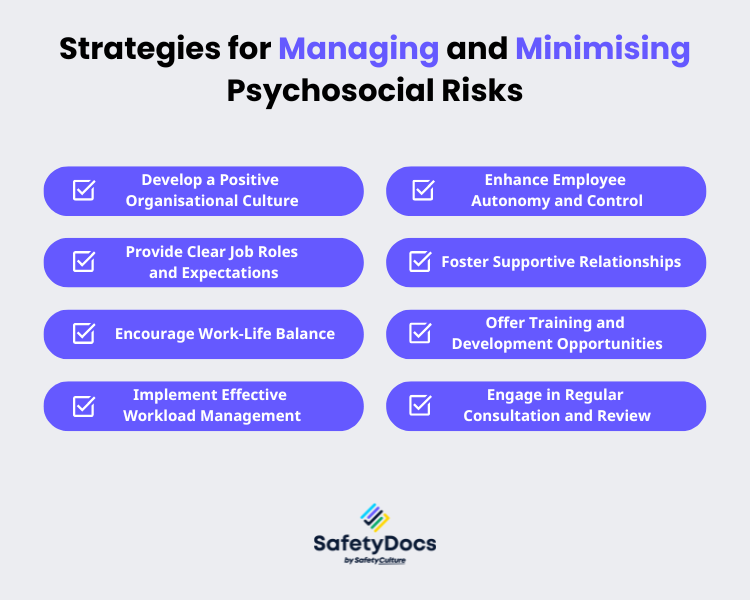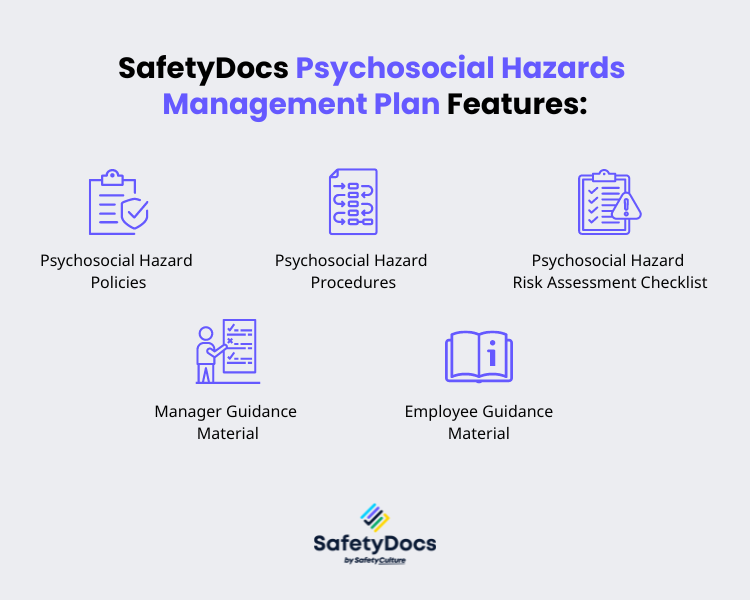Psychosocial hazards are becoming an increasingly important topic in Australian workplaces, significantly impacting employees’ mental and physical health, job satisfaction, and overall well-being. Common psychosocial risks, as outlined in Safe Work Australia's model Code of Practice, include specific risks that can harm workers, especially those who face barriers in understanding or engaging with safety processes. The consequences of these hazards have become so substantial that respective state governments are enacting regulations and introducing new codes of practice to address the issue.
This blog aims to raise awareness about psychosocial hazards, guide employers and employees on identifying and managing these risks, and discuss Australia’s evolving legal and regulatory framework in response to the growing concern. We will cover topics such as understanding psychosocial hazards, identifying and managing them in the workplace, the role of state government regulations and codes of practice, and sharing case studies of organisations that have successfully addressed these challenges, all while highlighting the support and resources our company can offer.
Psychosocial or Psychological; What’s the difference?
In a workplace setting, psychological and occupational health refer to the mental and emotional aspects that affect an individual’s well-being, performance, and overall experience at work. On the other hand, psychosocial factors cover a broader social context, including the relationships and interactions between individuals or groups at work, which also impact well-being and workplace performance.
The following workplace analogy illustrates the difference between psychological harm and psychosocial hazards:
Imagine that you have two employees, Sue and Dave. Both are experiencing work-related stress, but for different reasons.
Sue’s stress is primarily due to psychological factors. She is struggling with self-doubt and feels overwhelmed by her high job demands sometimes. This may result from personal characteristics, such as her self-esteem level or ability to cope with stress. To address Sue’s stress, the focus should be on her individual needs, which may involve providing stress management training, counselling, or adjusting her workload.
In contrast, Dave’s stress response is driven by psychosocial factors. He feels stressed because of ongoing conflicts with his coworkers, which create a hostile work environment. In this case, the focus should be on addressing the social dynamics and relationships within the workplace, such as providing conflict resolution training, team-building activities, positive feedback, or even restructuring the team if necessary.
In summary, psychological factors focus on the individual’s mental and emotional well-being, while psychosocial factors consider the broader social context and interactions within the workplace. Both aspects can significantly impact an employee’s overall work experience.

Understanding Psychosocial Hazards
Psychosocial hazards are aspects of the work environment that can harm someone's mental health and negatively impact an individual’s physical and psychological health and emotional well-being. These hazards can arise from various sources within the workplace, such as organisational culture, work demands, or poor workplace relationships. Psychosocial hazards can cause serious psychological or physical harm in several ways:
- Stress: Exposure to psychosocial hazards can increase stress levels, harming mental and physical health. Chronic stress can contribute to conditions such as anxiety, depression, sleep disturbances, and burnout.
- Mental health issues: Prolonged exposure to psychosocial hazards and traumatic events can lead to mental health problems, such as anxiety disorders, depression, and post-traumatic stress disorder. These conditions can significantly impact an individual’s well-being, job performance, and personal life.
- Physical health problems: The stress and strain caused by work related violence serious injury, and psychosocial hazards can manifest as actual physical injury, such as headaches, digestive problems, cardiovascular issues, and weakened immune systems. These health problems can result in increased absenteeism and reduced productivity.
- Job dissatisfaction and reduced engagement: Psychosocial and psychological safety hazards can lead to a negative work experience, causing employees to become disengaged or dissatisfied with their jobs. This can result in decreased motivation, poor performance, low recognition, and higher staff turnover.
- Interpersonal conflicts: A toxic work environment can create or exacerbate interpersonal conflicts between employees, leading to increased stress, reduced team cohesion, and a breakdown in communication. These conflicts can also contribute to workplace bullying, occupational violence and sexual harassment.
- Reduced productivity and performance: Psychosocial hazards can impair an employee’s ability to concentrate, make decisions, and perform other job tasks more efficiently. This can lead to reduced productivity, poor quality, increased error rates, and potentially compromised safety due to the work-related stress.
- Impact on personal life: The effects of psychosocial hazards in the workplace can extend beyond work and negatively impact an individual’s personal life, relationships, and overall well-being.
Impact of Psychosocial Hazards on Organisations
Although psychosocial hazards affect employees’ well-being, the consequences of not managing these risks can also be costly for employers. For instance, the increased stress levels and decreased job satisfaction associated with psychosocial hazards can lead to higher absenteeism rates and lower productivity levels, resulting in reduced profitability for the organisation.
Inherent psychosocial hazards are embedded in how jobs and tasks are designed, organised, managed, and supervised. These hazards can lead to work-related stress and psychological harm, depending on the nature of the work environment and social interactions at the workplace.
Increased turnover rates can also result in increased recruitment and training costs for the employer, and if an organisation is found to be in breach of its legal obligations to provide a safe and healthy workplace, it may be subjected to fines, legal fees, and reputational damage. So it’s important to recognise the potential impact of psychological hazards and take proactive steps to identify and manage these risks.
Employers can mitigate the risks associated with psychosocial hazards by creating a supportive work environment, training employees on stress management and conflict resolution, and putting in policies that foster healthy relationships. And, ultimately, protect employees’ health and well-being while safeguarding the bottom line.
Regulatory Framework in Australia
In Australia, workplace health and safety legislation and regulations require employers to provide a safe work environment, including addressing psychosocial hazards.
At the core of Australia’s regulatory framework for psychosocial hazards is the Work Health and Safety (WHS) legislation. This legislation, which includes the Work Health and Safety Act and Work Health and Safety Regulations, is designed to ensure the safety and well-being of workers. The WHS laws are enacted and enforced by each state and territory, with Safe Work Australia providing guidance and support at the national level.
The Primary Duty of Care
Under the WHS legislation, business owners, known as Persons Conducting a Business or Undertaking (PCBUs), have a duty of care to ensure the health and safety of their workers, including child protection workers from psychosocial hazards and managing hazardous working environments. These health and safety duties include:
- Providing a safe work environment
- Ensuring safe systems of work
- Providing appropriate training, supervision, and information to workers
- Consulting with workers on matters affecting their health and safety
Legally Managing Psychosocial Risks
Regulations require that to manage hazardous physical working environments and manage psychosocial risks, business owners should adopt a systematic approach that involves:
A. Identifying Hazards: Assess the workplace for potential psychosocial hazards such risk factors such as excessive workload, tight deadlines, bullying, or a lack of support.
B. Assessing Risks: Evaluate the likelihood and severity of potential or actual harm caused by the identified hazards to assist in managing psychosocial risks.
C. Implementing Control Measures: Implement strategies to reduce or eliminate the risks associated with psychosocial hazards. This may include job redesign, flexible work arrangements, or providing mental health support services.
D. Monitoring and Reviewing: Regularly review the effectiveness of implemented control measures and adjust them as necessary to maintain a safe work environment.
Identifying Psychosocial Hazards in the Workplace
Identifying psychosocial hazards in the workplace is crucial for ensuring employee well-being and creating a supportive work environment. A variety of methods can be employed to gather information on potential work related psychosocial hazards, allowing organisations to take proactive steps and offer practical assistance with these issues. This section will explore various methods for identifying psychosocial hazards, including surveys, interviews, observations, and stakeholder involvement.
Surveys
Questionnaires and surveys effectively gather employee feedback on various aspects of the work environment. These tools can help assess workload, job demands, workplace relationships, and organisational culture. Surveys can be conducted anonymously, encouraging employees to provide honest feedback without fear of repercussions. By analysing survey data, organisations can identify areas of concern and develop targeted strategies to address psychosocial hazards.
Interviews
One-on-one interviews or focus groups can provide valuable insights into employees’ experiences and perceptions of psychosocial hazards. This method allows for a more in-depth exploration of specific issues, as employees can share personal anecdotes and discuss their feelings openly. Interviews also enable employers to ask follow-up questions and better understand the root causes of psychosocial hazards. The information gathered from interviews can then help develop effective interventions.
Observations
Directly observing workplace interactions, processes, and conditions can help identify potential psychosocial hazards. By observing employees in their work environment, managers can detect issues such as poor communication, inadequate support resources, poor organisational change management and signs of stress or burnout. Observations should be documented to ensure that all relevant factors are considered when developing strategies to address psychosocial hazards.
Stakeholder Involvement
Involving employees and other stakeholders, such as health and safety representatives, in the identification process can provide a more accurate picture of the work environment. Their input can help identify issues that might not be immediately apparent, as well as contribute to the development of practical solutions. Engaging stakeholders in the risk management process also fosters a sense of ownership and commitment to addressing psychosocial hazards, creating a supportive and collaborative atmosphere.

Strategies for Managing and Minimising Psychosocial Risks
Now that we’ve discussed the legal framework, effects, and identification of psychosocial hazards, it’s time to explore strategies for managing and preventing these hazards in the workplace. By implementing effective strategies, business owners can foster a healthy work environment, avoid psychological injury, boost productivity and reduce potential legal issues. In this section, we will outline some key strategies to help you manage and prevent psychosocial hazards in your workplace.
Develop a Positive Organisational Culture
Creating a positive organisational culture is crucial for preventing and managing psychosocial hazards. Encourage open communication, trust, and collaboration among employees and managers, demonstrate your commitment to employee well-being, and provide resources for mental health support. Recognise and reward employees’ efforts and achievements to boost morale and job satisfaction.
Provide Clear Job Roles and Expectations
Ensure that employees clearly understand their job roles, responsibilities, and expectations. Regularly provide feedback on performance and discuss any concerns or issues. This can help reduce role ambiguity, low job control, conflict, and work-related stress.
Encourage Work-Life Balance
Promote a healthy work-life balance by offering flexible work arrangements, such as telecommuting, part-time work, or flexible hours. Encourage employees to take regular breaks and use their annual leave to recharge and maintain mental well-being.
Implement Effective Workload Management
Monitor and manage workloads to prevent excessive job demands and burnout. Assign and complete tasks based on employees’ skills and capabilities, and ensure they have sufficient resources and support to complete their work. Regularly review workloads and adjust them to maintain a sustainable work pace.
Enhance Employee Autonomy and Control
Allow employees to have a say in their work processes, where possible, and involve them in decision-making. This can help increase employees’ sense of control and autonomy, reducing stress and improving job satisfaction.
Foster Supportive Relationships
Promote a supportive work environment by encouraging positive employee interactions and training managers on effective communication and leadership. Implement a zero-tolerance policy for workplace bullying, harassment, and discrimination, and ensure that employees can access confidential channels for reporting incidents.
Offer Training and Development Opportunities
Provide employees with opportunities for skill development and career advancement. This can help increase job satisfaction, motivation, and engagement and reduce the risk of work-related stress.
Engage in Regular Consultation and Review
Involve employees in identifying, assessing, and controlling psychosocial hazards. Regularly review and update your strategies to ensure they are effectively managed and prevent psychosocial risks.

Common Psychosocial Hazards - Case Studies
Let’s look at a couple of case studies to see how two companies might use different approaches:
| Company A | Company B |
|
Company A, a leading Australian retailer, recognised the impact of psychosocial hazards on its workforce and took proactive steps to address these challenges. They implemented a comprehensive mental health and well-being program that included mental health training for managers, an employee assistance program, and regular well-being surveys. The mental health training for managers equipped them with the necessary skills to recognise early signs of employee distress and provide appropriate support. The employee assistance program offered confidential counselling services to address work-related and personal issues. Regular well-being surveys allowed the organisation to monitor employee satisfaction, stress levels, and overall mental health, enabling them to make data-driven decisions and continuously improve their support initiatives. As a result, the company experienced a significant reduction in staff turnover, improved employee satisfaction, and increased productivity. The success of this approach demonstrated the value of investing in employee well-being and served as an example for other businesses in the retail sector. |
Company B, a medium-sized manufacturing firm, successfully addressed workplace violence, bullying and harassment by implementing a zero-tolerance policy, providing training on conflict resolution, and establishing a confidential reporting system. The zero-tolerance policy clearly communicated the company’s commitment to maintaining a respectful work environment and outlined the consequences for those who engaged in bullying or harassment. This policy was reinforced through training sessions on conflict resolution, which equipped employees with the skills to navigate difficult situations, communicate effectively, and resolve conflicts healthily and constructively. The confidential reporting system allowed employees to report incidents of unreasonable behaviour without fear of retaliation, ensuring that such issues were addressed promptly and effectively. In addition to these measures, the company organised regular team-building activities to foster a sense of camaraderie and mutual support among employees. These initiatives led to improved workplace relationships, reduced staff turnover, and enhanced employee well-being. |
Company B’s approach to addressing workplace bullying and harassment highlighted the importance of creating a positive work culture and demonstrated the benefits of addressing psychosocial hazards proactively.
Implementing a Psychosocial Risk Management Plan
As explored throughout this blog post, addressing psychosocial hazards in the workplace is crucial for ensuring employee well-being, boosting productivity, and reducing potential legal issues. Developing and implementing a Psychosocial Hazards Management Plan is an effective way to take a proactive and structured approach to managing these hazards and provide emotional support to affected workers.
SafetyDocs by SafetyCulture’s Psychosocial Hazards Management Plan offers a range of valuable features to help businesses tackle this issue head-on, including:
- A Psychosocial Hazard Policy: Our policy clearly outlines the roles and responsibilities of employees and managers in managing psychosocial hazards. It serves as a foundation for creating a supportive work environment and addressing psychosocial risks effectively.
- Psychosocial Hazard Procedures: With our step-by-step procedures, employers can confidently implement the policy, ensuring a consistent and structured approach to managing psychosocial hazards. These procedures cover essential aspects such as risk assessment, communication, and monitoring and evaluation.
- Bullying Policy & Procedures: Offers clear guidelines and strategies to manage and prevent instances of workplace bullying.
- Domestic Violence & DV Workplace Safety Plan: Outlines steps to support employees affected by domestic violence, promoting safety within the workplace.
- Drugs and Alcohol Policy: Sets out procedures to address substance misuse, contributing to a healthier and safer work environment.
- Workplace Fatigue Policy: Provides guidance on identifying and managing employee fatigue, promoting overall well-being.
- Sexual Harassment Policy: Details processes to prevent and address cases of sexual harassment, fostering respect and dignity in the workplace.
- Psychosocial Risk Assessment Checklist: Our user-friendly but comprehensive checklist empowers employers to identify and assess psychosocial hazards in their workplace. By covering a range of key areas, such as workload, relationships, and organisational culture, this checklist enables employers to address potential concerns proactively.
- Manager Guidance Material: We provide practical tips and advice to help managers understand and fulfil their role in managing psychosocial hazards. Our guidance material equips managers with the tools to create a supportive work environment and address team hazards.
- Employee Guidance Material: Our employee-focused guidance material helps workers understand their role in managing psychosocial hazards. It offers practical tips and advice on identifying and reporting hazards and how to support colleagues in maintaining a healthy work environment.
In summary, a Psychosocial Hazards Management Plan offers a comprehensive and effective approach to identifying, assessing, and managing psychosocial hazards in the workplace. By adopting and implementing our plan, businesses can create a supportive, healthy, and productive work environment that benefits both employees and the organisation as a whole.
|

Additional Online Resources
Online resources can be invaluable for gathering information and assisting in managing psychosocial hazards in Australian workplaces. Safe Work Australia is the leading national authority on work health and safety. Their website offers a wealth of resources, including guidelines, fact sheets, and codes of practice related to psychosocial hazards.
Additionally, the Heads Up initiative developed by Beyond Blue and supported by Safe Work Australia, SANE Australia, Lifeline, and the Black Dog Institute provide resources and tools to help businesses create mentally healthy workplaces.
Each state and territory also have its own work health and safety regulatory bodies, such as WorkSafe QLD and SafeWork NSW, which offer localised information and support.
By leveraging SafetyDocs by SafetyCulture products supported by online resources, you can stay informed and access the guidance necessary to manage workplace psychosocial hazards effectively.
Author - Craig Cruickshank is the HSEQ Advisor/Project Manager at SafetyDocs by SafetyCulture.
Craig comes from a construction and environmental background, with experience in both the private and public sectors and is passionate about making health and safety information easy to find and understand for everyone.
Learn more about Craig's work on LinkedIn
Available for instant download and supplied in fully editable MS Word format for use in your business.
Please note that the above information is provided as a comment only and should not be relied on as professional, legal or financial advice.
Share This Article
